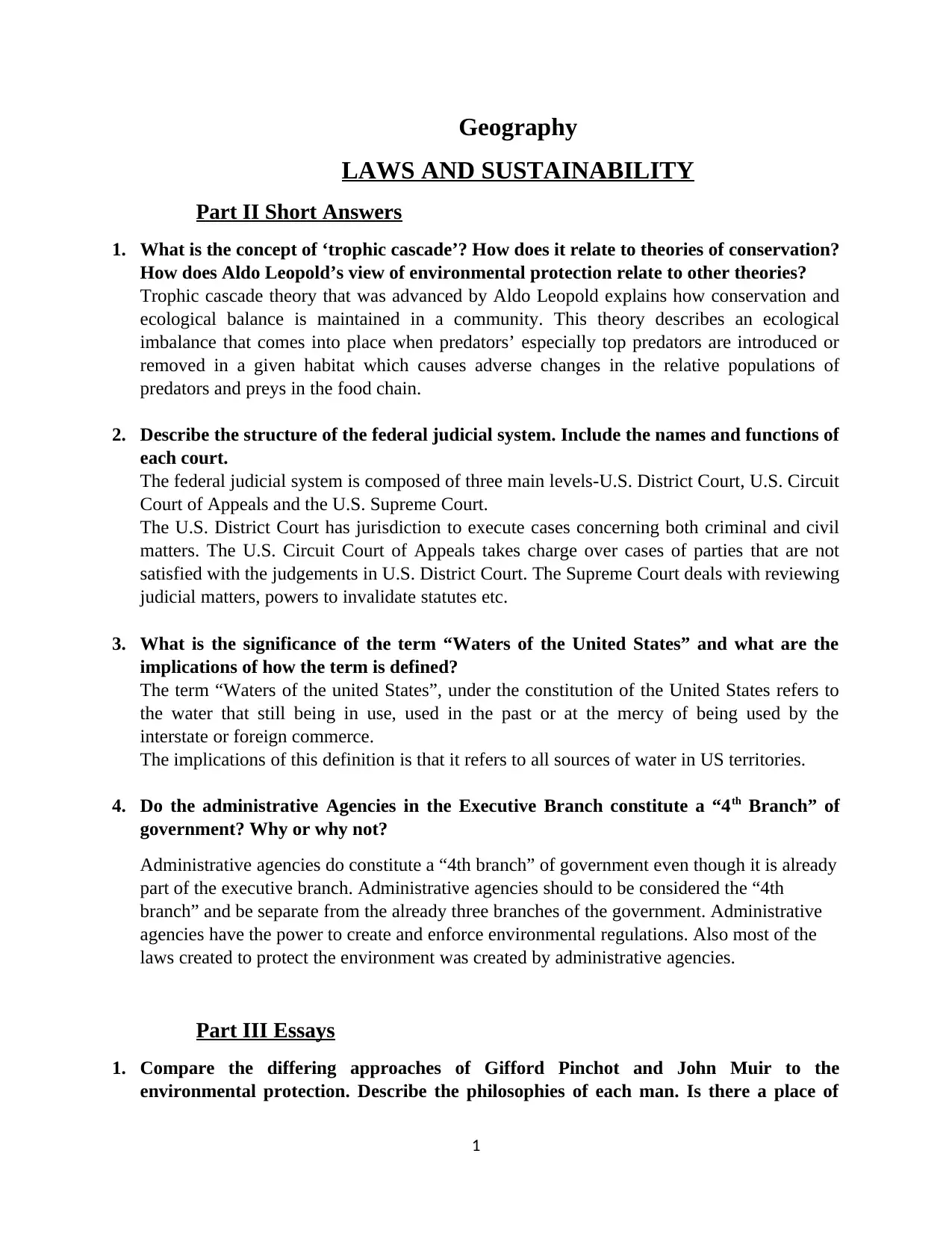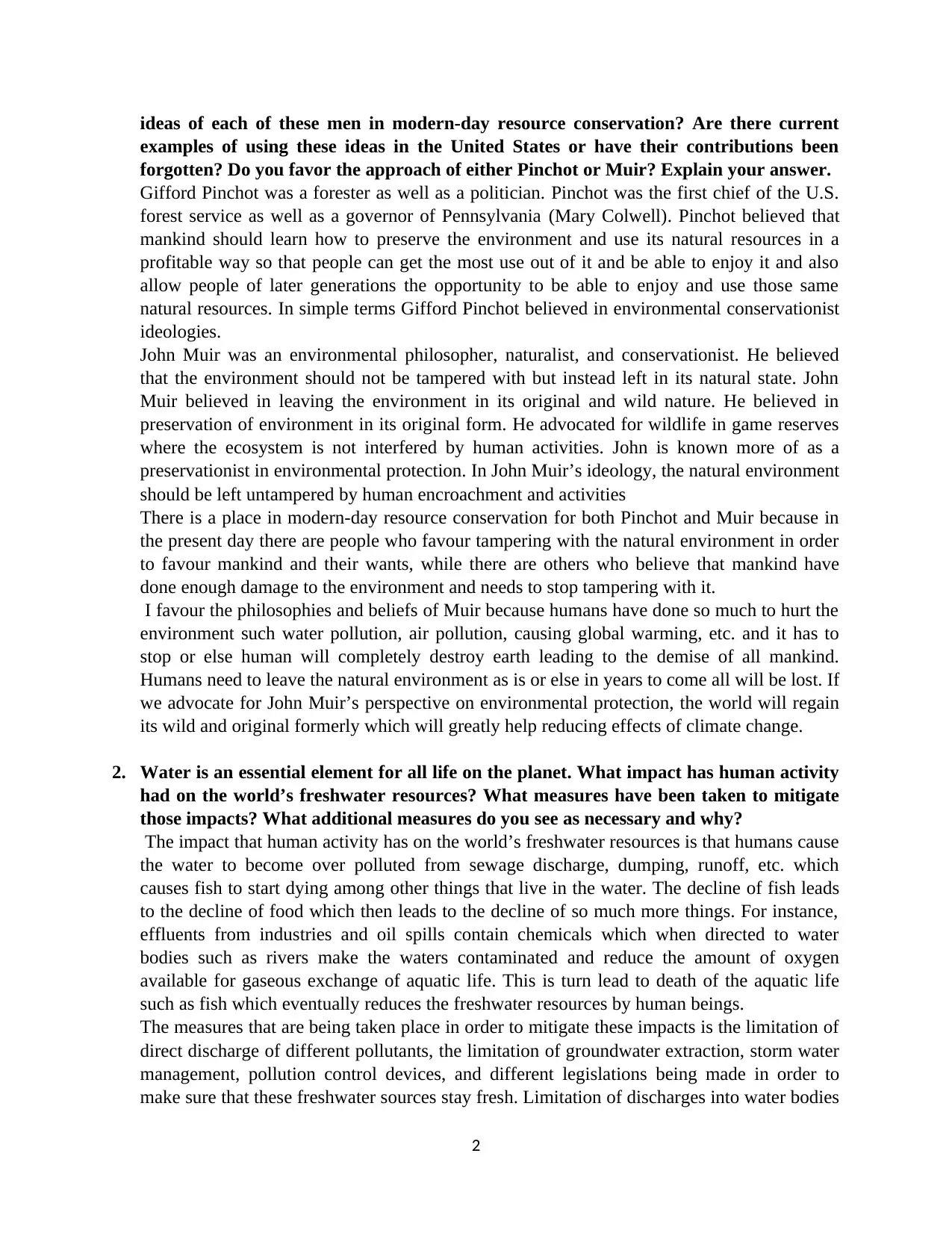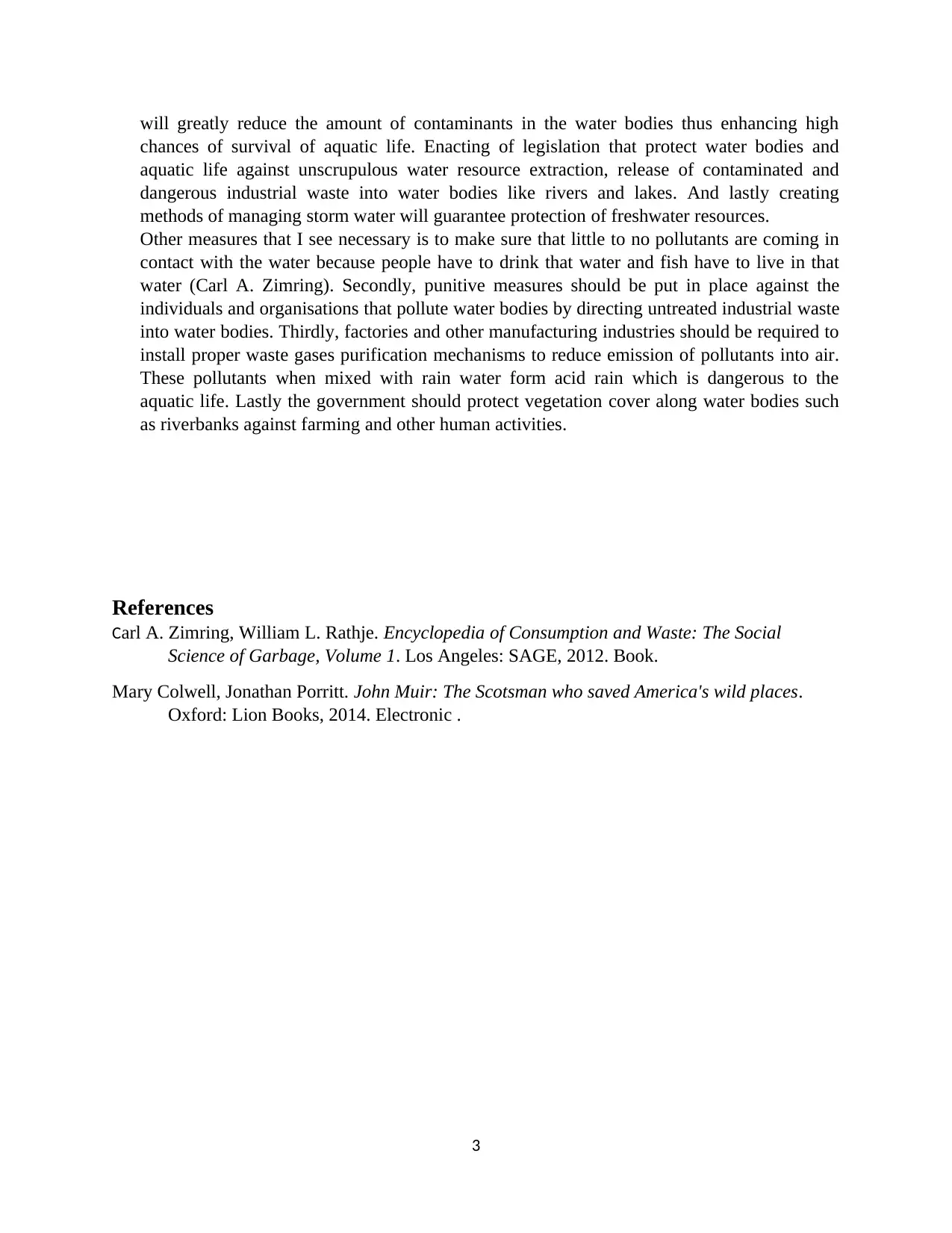Geography Assignment: LAWS and Sustainability - Essays & Answers
VerifiedAdded on 2022/08/20
|3
|1329
|8
Homework Assignment
AI Summary
This Geography assignment addresses key concepts in environmental science and sustainability. The assignment explores the theory of trophic cascades, its relevance to conservation, and Aldo Leopold's perspective on environmental protection. It also details the structure of the federal judicial system. Furthermore, the assignment delves into the philosophies of Gifford Pinchot and John Muir, comparing their approaches to environmental protection and discussing their relevance in modern conservation. The impact of human activities on freshwater resources, including pollution and mitigation measures, is also examined, with additional measures for protection suggested. The assignment provides a comprehensive overview of environmental laws, sustainability, and the critical balance between human activity and ecological preservation, offering insights into historical perspectives and contemporary challenges in resource management.

Geography
LAWS AND SUSTAINABILITY
Part II Short Answers
1. What is the concept of ‘trophic cascade’? How does it relate to theories of conservation?
How does Aldo Leopold’s view of environmental protection relate to other theories?
Trophic cascade theory that was advanced by Aldo Leopold explains how conservation and
ecological balance is maintained in a community. This theory describes an ecological
imbalance that comes into place when predators’ especially top predators are introduced or
removed in a given habitat which causes adverse changes in the relative populations of
predators and preys in the food chain.
2. Describe the structure of the federal judicial system. Include the names and functions of
each court.
The federal judicial system is composed of three main levels-U.S. District Court, U.S. Circuit
Court of Appeals and the U.S. Supreme Court.
The U.S. District Court has jurisdiction to execute cases concerning both criminal and civil
matters. The U.S. Circuit Court of Appeals takes charge over cases of parties that are not
satisfied with the judgements in U.S. District Court. The Supreme Court deals with reviewing
judicial matters, powers to invalidate statutes etc.
3. What is the significance of the term “Waters of the United States” and what are the
implications of how the term is defined?
The term “Waters of the united States”, under the constitution of the United States refers to
the water that still being in use, used in the past or at the mercy of being used by the
interstate or foreign commerce.
The implications of this definition is that it refers to all sources of water in US territories.
4. Do the administrative Agencies in the Executive Branch constitute a “4th Branch” of
government? Why or why not?
Administrative agencies do constitute a “4th branch” of government even though it is already
part of the executive branch. Administrative agencies should to be considered the “4th
branch” and be separate from the already three branches of the government. Administrative
agencies have the power to create and enforce environmental regulations. Also most of the
laws created to protect the environment was created by administrative agencies.
Part III Essays
1. Compare the differing approaches of Gifford Pinchot and John Muir to the
environmental protection. Describe the philosophies of each man. Is there a place of
1
LAWS AND SUSTAINABILITY
Part II Short Answers
1. What is the concept of ‘trophic cascade’? How does it relate to theories of conservation?
How does Aldo Leopold’s view of environmental protection relate to other theories?
Trophic cascade theory that was advanced by Aldo Leopold explains how conservation and
ecological balance is maintained in a community. This theory describes an ecological
imbalance that comes into place when predators’ especially top predators are introduced or
removed in a given habitat which causes adverse changes in the relative populations of
predators and preys in the food chain.
2. Describe the structure of the federal judicial system. Include the names and functions of
each court.
The federal judicial system is composed of three main levels-U.S. District Court, U.S. Circuit
Court of Appeals and the U.S. Supreme Court.
The U.S. District Court has jurisdiction to execute cases concerning both criminal and civil
matters. The U.S. Circuit Court of Appeals takes charge over cases of parties that are not
satisfied with the judgements in U.S. District Court. The Supreme Court deals with reviewing
judicial matters, powers to invalidate statutes etc.
3. What is the significance of the term “Waters of the United States” and what are the
implications of how the term is defined?
The term “Waters of the united States”, under the constitution of the United States refers to
the water that still being in use, used in the past or at the mercy of being used by the
interstate or foreign commerce.
The implications of this definition is that it refers to all sources of water in US territories.
4. Do the administrative Agencies in the Executive Branch constitute a “4th Branch” of
government? Why or why not?
Administrative agencies do constitute a “4th branch” of government even though it is already
part of the executive branch. Administrative agencies should to be considered the “4th
branch” and be separate from the already three branches of the government. Administrative
agencies have the power to create and enforce environmental regulations. Also most of the
laws created to protect the environment was created by administrative agencies.
Part III Essays
1. Compare the differing approaches of Gifford Pinchot and John Muir to the
environmental protection. Describe the philosophies of each man. Is there a place of
1
Paraphrase This Document
Need a fresh take? Get an instant paraphrase of this document with our AI Paraphraser

ideas of each of these men in modern-day resource conservation? Are there current
examples of using these ideas in the United States or have their contributions been
forgotten? Do you favor the approach of either Pinchot or Muir? Explain your answer.
Gifford Pinchot was a forester as well as a politician. Pinchot was the first chief of the U.S.
forest service as well as a governor of Pennsylvania (Mary Colwell). Pinchot believed that
mankind should learn how to preserve the environment and use its natural resources in a
profitable way so that people can get the most use out of it and be able to enjoy it and also
allow people of later generations the opportunity to be able to enjoy and use those same
natural resources. In simple terms Gifford Pinchot believed in environmental conservationist
ideologies.
John Muir was an environmental philosopher, naturalist, and conservationist. He believed
that the environment should not be tampered with but instead left in its natural state. John
Muir believed in leaving the environment in its original and wild nature. He believed in
preservation of environment in its original form. He advocated for wildlife in game reserves
where the ecosystem is not interfered by human activities. John is known more of as a
preservationist in environmental protection. In John Muir’s ideology, the natural environment
should be left untampered by human encroachment and activities
There is a place in modern-day resource conservation for both Pinchot and Muir because in
the present day there are people who favour tampering with the natural environment in order
to favour mankind and their wants, while there are others who believe that mankind have
done enough damage to the environment and needs to stop tampering with it.
I favour the philosophies and beliefs of Muir because humans have done so much to hurt the
environment such water pollution, air pollution, causing global warming, etc. and it has to
stop or else human will completely destroy earth leading to the demise of all mankind.
Humans need to leave the natural environment as is or else in years to come all will be lost. If
we advocate for John Muir’s perspective on environmental protection, the world will regain
its wild and original formerly which will greatly help reducing effects of climate change.
2. Water is an essential element for all life on the planet. What impact has human activity
had on the world’s freshwater resources? What measures have been taken to mitigate
those impacts? What additional measures do you see as necessary and why?
The impact that human activity has on the world’s freshwater resources is that humans cause
the water to become over polluted from sewage discharge, dumping, runoff, etc. which
causes fish to start dying among other things that live in the water. The decline of fish leads
to the decline of food which then leads to the decline of so much more things. For instance,
effluents from industries and oil spills contain chemicals which when directed to water
bodies such as rivers make the waters contaminated and reduce the amount of oxygen
available for gaseous exchange of aquatic life. This is turn lead to death of the aquatic life
such as fish which eventually reduces the freshwater resources by human beings.
The measures that are being taken place in order to mitigate these impacts is the limitation of
direct discharge of different pollutants, the limitation of groundwater extraction, storm water
management, pollution control devices, and different legislations being made in order to
make sure that these freshwater sources stay fresh. Limitation of discharges into water bodies
2
examples of using these ideas in the United States or have their contributions been
forgotten? Do you favor the approach of either Pinchot or Muir? Explain your answer.
Gifford Pinchot was a forester as well as a politician. Pinchot was the first chief of the U.S.
forest service as well as a governor of Pennsylvania (Mary Colwell). Pinchot believed that
mankind should learn how to preserve the environment and use its natural resources in a
profitable way so that people can get the most use out of it and be able to enjoy it and also
allow people of later generations the opportunity to be able to enjoy and use those same
natural resources. In simple terms Gifford Pinchot believed in environmental conservationist
ideologies.
John Muir was an environmental philosopher, naturalist, and conservationist. He believed
that the environment should not be tampered with but instead left in its natural state. John
Muir believed in leaving the environment in its original and wild nature. He believed in
preservation of environment in its original form. He advocated for wildlife in game reserves
where the ecosystem is not interfered by human activities. John is known more of as a
preservationist in environmental protection. In John Muir’s ideology, the natural environment
should be left untampered by human encroachment and activities
There is a place in modern-day resource conservation for both Pinchot and Muir because in
the present day there are people who favour tampering with the natural environment in order
to favour mankind and their wants, while there are others who believe that mankind have
done enough damage to the environment and needs to stop tampering with it.
I favour the philosophies and beliefs of Muir because humans have done so much to hurt the
environment such water pollution, air pollution, causing global warming, etc. and it has to
stop or else human will completely destroy earth leading to the demise of all mankind.
Humans need to leave the natural environment as is or else in years to come all will be lost. If
we advocate for John Muir’s perspective on environmental protection, the world will regain
its wild and original formerly which will greatly help reducing effects of climate change.
2. Water is an essential element for all life on the planet. What impact has human activity
had on the world’s freshwater resources? What measures have been taken to mitigate
those impacts? What additional measures do you see as necessary and why?
The impact that human activity has on the world’s freshwater resources is that humans cause
the water to become over polluted from sewage discharge, dumping, runoff, etc. which
causes fish to start dying among other things that live in the water. The decline of fish leads
to the decline of food which then leads to the decline of so much more things. For instance,
effluents from industries and oil spills contain chemicals which when directed to water
bodies such as rivers make the waters contaminated and reduce the amount of oxygen
available for gaseous exchange of aquatic life. This is turn lead to death of the aquatic life
such as fish which eventually reduces the freshwater resources by human beings.
The measures that are being taken place in order to mitigate these impacts is the limitation of
direct discharge of different pollutants, the limitation of groundwater extraction, storm water
management, pollution control devices, and different legislations being made in order to
make sure that these freshwater sources stay fresh. Limitation of discharges into water bodies
2

will greatly reduce the amount of contaminants in the water bodies thus enhancing high
chances of survival of aquatic life. Enacting of legislation that protect water bodies and
aquatic life against unscrupulous water resource extraction, release of contaminated and
dangerous industrial waste into water bodies like rivers and lakes. And lastly creating
methods of managing storm water will guarantee protection of freshwater resources.
Other measures that I see necessary is to make sure that little to no pollutants are coming in
contact with the water because people have to drink that water and fish have to live in that
water (Carl A. Zimring). Secondly, punitive measures should be put in place against the
individuals and organisations that pollute water bodies by directing untreated industrial waste
into water bodies. Thirdly, factories and other manufacturing industries should be required to
install proper waste gases purification mechanisms to reduce emission of pollutants into air.
These pollutants when mixed with rain water form acid rain which is dangerous to the
aquatic life. Lastly the government should protect vegetation cover along water bodies such
as riverbanks against farming and other human activities.
References
Carl A. Zimring, William L. Rathje. Encyclopedia of Consumption and Waste: The Social
Science of Garbage, Volume 1. Los Angeles: SAGE, 2012. Book.
Mary Colwell, Jonathan Porritt. John Muir: The Scotsman who saved America's wild places.
Oxford: Lion Books, 2014. Electronic .
3
chances of survival of aquatic life. Enacting of legislation that protect water bodies and
aquatic life against unscrupulous water resource extraction, release of contaminated and
dangerous industrial waste into water bodies like rivers and lakes. And lastly creating
methods of managing storm water will guarantee protection of freshwater resources.
Other measures that I see necessary is to make sure that little to no pollutants are coming in
contact with the water because people have to drink that water and fish have to live in that
water (Carl A. Zimring). Secondly, punitive measures should be put in place against the
individuals and organisations that pollute water bodies by directing untreated industrial waste
into water bodies. Thirdly, factories and other manufacturing industries should be required to
install proper waste gases purification mechanisms to reduce emission of pollutants into air.
These pollutants when mixed with rain water form acid rain which is dangerous to the
aquatic life. Lastly the government should protect vegetation cover along water bodies such
as riverbanks against farming and other human activities.
References
Carl A. Zimring, William L. Rathje. Encyclopedia of Consumption and Waste: The Social
Science of Garbage, Volume 1. Los Angeles: SAGE, 2012. Book.
Mary Colwell, Jonathan Porritt. John Muir: The Scotsman who saved America's wild places.
Oxford: Lion Books, 2014. Electronic .
3
⊘ This is a preview!⊘
Do you want full access?
Subscribe today to unlock all pages.

Trusted by 1+ million students worldwide
1 out of 3
Your All-in-One AI-Powered Toolkit for Academic Success.
+13062052269
info@desklib.com
Available 24*7 on WhatsApp / Email
![[object Object]](/_next/static/media/star-bottom.7253800d.svg)
Unlock your academic potential
Copyright © 2020–2025 A2Z Services. All Rights Reserved. Developed and managed by ZUCOL.